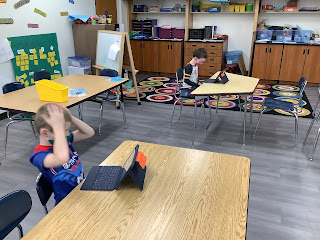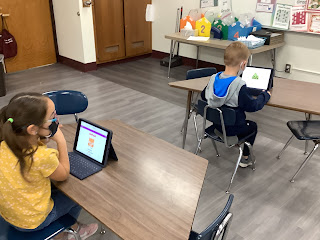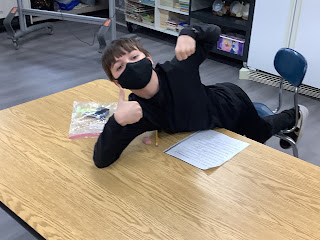1st Grade: The Over/Under Substitution Cipher
We had a jam-packed
week! We started off with a worksheet to
get our brains thinking about our next puzzles we will be completing. The students were given a word and a clue to
a new word that had to come up with by changing only one letter in the first
word. They rocked with this
assignment. Then, it was onto our new
secret message – The Over/Under Cipher. After
a quick hint to use the title as the clue, I quickly heard a student say to
switch out the letters with the letter on top of it or below it. Eureka!
They were on their way to solving their new secret message: Hip, hip hooray for the alphabet! This led us into our book The Disappearing Alphabet
by Richard Wilbur.
We used this book to model how to complete our reading analyzer. The reading analyzer is a tool used to help
us understand our reading and look for the deeper meaning to a story. We walked through the steps of how to
complete it. By the time we got to the
main idea of the story, I quickly heard the students talk about how important
the alphabet is and each letter in it.
They got it!
We will continue with this lesson after thanksgiving break.
2nd Grade: The Tale of Despereaux
We are so close to the end of our first novel study! We started book the 4th and have seen how all our characters were destined to meet each other. All 3 stories are playing out together as we read the last book. We held a class discussion on what it meant to hold a grudge and how holding a grudge can hurt ourselves.
We will wrap up the book in the next week and complete some different wrap-up activities.
3rd Grade: A Tall Tale
We continued
are comparison of a myth/legend to a tall tale.
This week they completed a VENN diagram to help us visualize the
comparison. I showed them a third circle
we will add onto our VENN diagram in a week and to keep that in mind as we read
Billy Beg and his Bull. As I read this
folklore, they were given the task of marking down any exaggeration they heard
in the story. We paused halfway through
and took a vote as to what the genre might be and using some good clues, they
eliminated myth because it was not written to explain the unexplainable. They also considered eliminating a tall tale
as it did not have enough extreme exaggeration.
This led them to all agree that it must be a legend. As we got to the ending of our story, I heard
a student mention how similar the ending was to Cinderella. We only had a few minutes left at this point,
but this led them to agreeing the genre was a fairy tale. We backtracked for a moment about one big
hint they all missed in the beginning of the story…the famous words of Once
Upon a Time. We briefly discussed that
this is a characteristic that they will see in our fairy tales.
We will continue
with this lesson after thanksgiving break.
4th Grade: A Change Maker
We are officially
cruising on our change maker project! We
looked at an outline of the overall project and what will be expected of them
with this project. They moved onto their
next step of completing their biography summary. This step is very important that they complete
with lots of details as it serves as a big part of their notes. We came to an agreement of a spot that all
students thought they could complete by the end of next week. I
also gave them a paper and encouraged them to track their 10 or more important
facts with dates as they are reading. This
will help guide them to completing another part of their project as they are
researching verse back-tracking later.
One fun discovery the students saw was both of their change makers were
living in the same time period! It will be
interesting to see how the time period affected each of their projects in different ways.
We will continue with our project next week.
1st
Grade: What Happened?
It is game time again! This game adds onto our last game of Groupo. The students would draw a Groupo card and recreate the design. Then they would leave the table while the other person would spin for one of three options: take one away, move a shape or do nothing. Then, the other player would return and must guess What Happened to their shape. To end their turn, the student would have to say my shape was a________ and is a ____________ to discuss the shapes they see while playing the game.
2nd Grade: Think Deeply
It was time for another Think Deeply! These guys were amazing as they had LOTS to write about in their response. Together, we defined a basic shape in a tessellation. Then they had to identity the shapes that created it and discuss how they were connected. To end their response, they had to discuss the transformations used to create the tessellation. We used this time to review the definition of a basic unit and all our transformations. We have also introduced the terms reflection, rotation and translation. They do not need to master these terms at this point, but I was proud to see them remember two of them. The translation as a slide seems to be our tricky one. This one my friends always want to mix up with the word transformation. To end the week, we started to review and learn some of our tricks to mastering our multiplication. As a review for my students that have mastered most of their facts, this was a review as they became the teacher of the tricks for the day.
3rd Grade: Think Deeply
It is time for
another Think Deeply! The
students were asked to compare the multiples of 2 and 3 on the 100’s chart. They had to color in their multiples and
describe those patterns. Then, we
switched our focus to the overlaps of our multiples. The students quickly saw that these were
actually are multiples of our 6’s. They
were challenged with the task to explain what made those numbers the overlaps of
our 2’s and 3’s.
We will
start a new lesson after thanksgiving break.
4th Grade: Cover-Up
*I apologize for the smaller font, but I am having technical issues with the program when I try to enlarge it.
This week it was all about the cover-up method in algebra. This was a challenge for the students to wrap their brain around it because of us learning to solve equations already by working backwards and using inverse operations. I asked them to give it a try for those that were forgetting a few steps with our other method might find this way works better for them. We also talked about the chance that this is the method students are ultimately using when solving equations quickly in their mind and they did not even know it. Some students immediately stated this way is not for them.
Look below for a sample of the cover-up method. This is a great strategy for those that were struggling with the inverse operation to utilize.
4N + 6 = 22
1 – COVER-UP the 4N: 4N + 6 = 22
2 – Now ask yourself what number plus 6 equals 22.
16 + 6 = 22 which means 16 = 4N
3 - NEXT, ask yourself 4 times what number equals 16? 4 x 4 = 16
Your answer is 4 = N
To end the week, the students solved some more equations. This time they could use either method to solve it.


































No comments:
Post a Comment